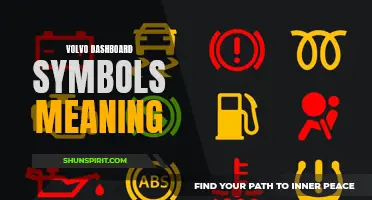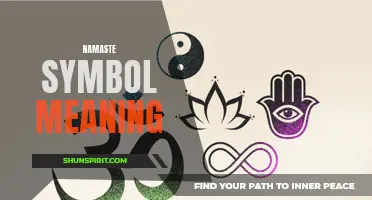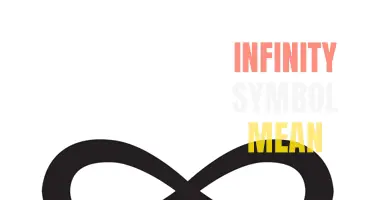
Headstones have served as a solemn reminder of those who have passed away for centuries. Beyond simply marking a grave, these stone monuments are often adorned with various symbols that hold deep meanings and tell a story about the deceased. From religious symbols to cultural icons, headstone symbols offer a glimpse into the life, beliefs, and values of the person buried beneath. Exploring the intricate significance behind these symbols can provide a fascinating look into history, culture, and the enduring legacy of those who came before us.
What You'll Learn
- What are some common symbols found on headstones and what do they mean?
- How do the symbols and meanings on headstones differ between different cultures and religions?
- Are there any symbols on headstones that have lost their meaning or are no longer widely used?
- Are there any symbols on headstones that have evolved or changed their meaning over time?
- How do families and individuals choose which symbols to include on a loved one's headstone and what factors influence this decision?

What are some common symbols found on headstones and what do they mean?
When visiting a cemetery, you may have noticed that many headstones are adorned with various symbols. These symbols often hold great significance and can provide insights into the life, beliefs, or profession of the individual buried there. Here are some common symbols found on headstones and their meanings:
- Cross: The cross is one of the most recognizable symbols in Christianity and represents faith, hope, and everlasting life. It is a common symbol found on Christian graves.
- Anchor: The anchor symbolizes hope and is often associated with sailors. It represents stability and strength during turbulent times. The anchor can also signify a person's religious beliefs or their connection to the sea.
- Dove: The dove is a symbol of peace and is often associated with spirituality and the Holy Spirit. It represents purity, innocence, and divine love. Its presence on a headstone indicates a peaceful and gentle soul.
- Lamb: The lamb is a symbol of innocence and is often found on the graves of children. It represents the pure and gentle nature of a child's soul. The lamb can also symbolize the idea of sacrifice, as it is commonly associated with Jesus Christ's sacrificial role in Christianity.
- Tree: The tree is a symbol of life, growth, and wisdom. It represents the eternal cycle of life and the connection between heaven and earth. A tree on a headstone can signify a person's strong roots or their deep spirituality.
- Crossed Swords: Crossed swords are often found on the graves of military personnel and symbolize a warrior's bravery and dedication to their country. They represent a person's service and sacrifice for their nation.
- Butterfly: The butterfly is a symbol of transformation and resurrection. It represents the journey of the soul from this life to the afterlife and the possibility of new beginnings. The butterfly is often associated with beauty, grace, and the soul's eternal nature.
- Hourglass: The hourglass is a symbol of time and mortality. It reminds us of the fleeting nature of life and the inevitability of death. It serves as a reminder to make the most of the time we have and to cherish every moment.
- Open Book: The open book symbolizes knowledge, wisdom, and the teachings of the Bible. It represents a person's faith and their devotion to learning and understanding. It can also signify a person's desire to leave behind a legacy of wisdom and knowledge.
- Shield: The shield is a symbol of protection and defense. It represents a person's courage and strength to face life's challenges. It can also symbolize a person's noble character and their willingness to fight for their beliefs.
These are just a few examples of the symbols you may encounter on headstones. Each symbol holds personal meaning for the individual or their loved ones and can serve as a way to remember and honor their life. Next time you visit a cemetery, take a moment to appreciate the symbolism on the headstones and reflect on the lives they represent.
The Secret of the Scientology Symbol: Uncovering its Hidden Meaning
You may want to see also

How do the symbols and meanings on headstones differ between different cultures and religions?
Headstones serve as lasting tributes to the deceased, and they often contain symbols and words that hold significant meaning. These symbols and meanings can vary greatly between different cultures and religions, reflecting the beliefs and traditions of each group. Understanding the symbols and meanings on headstones can provide insight into the culture, religion, and even the personality of the deceased.
In Christian and Catholic traditions, common symbols found on headstones include crosses, angels, and doves. The cross represents the crucifixion of Jesus and is a symbol of faith and salvation. Angels are seen as messengers and guardians in Christianity, and they often represent protection and guidance. Doves are symbols of peace and the Holy Spirit. These symbols are used to convey the deceased's Christian faith and their hope for eternal life.
In Jewish traditions, headstones often feature Hebrew inscriptions and symbols such as the Star of David. The Star of David is a symbol of Judaism and represents the six points of the Star symbolizing the relationship between God and the Jewish people. Other symbols that may be seen are menorahs, representing the seven-branched candelabrum, and the chai symbol, which means "life" in Hebrew. These symbols reflect the deceased's Jewish identity and highlight their connection to their faith.
In Islamic traditions, headstones typically bear Arabic inscriptions and may include symbols such as the crescent moon and star. The crescent moon and star are symbols of Islam and can represent the Islamic calendar or the blessed nights of Ramadan. Arabic calligraphy is also commonly found on Islamic headstones, with texts from the Quran being inscribed. These symbols and writings reflect the deceased's devotion to Islam and their belief in the teachings of the Quran.
In Buddhist traditions, headstones may feature various symbols and imagery associated with Buddhism. One common symbol is the lotus flower, which represents purity and enlightenment. The Dharma wheel, representing the teachings of Buddha, is also frequently seen. Other symbols that may be present include the Buddha statue, representing the enlightened one, and the Bodhi tree, under which Buddha attained enlightenment. These symbols reflect the deceased's commitment to the Buddhist faith and their pursuit of spiritual awakening.
In Hindu traditions, headstones can display a variety of symbols and images associated with Hinduism. One common symbol is the Om symbol, representing the divine and the universe. Other symbols that may be found include Lord Ganesha, the elephant-headed deity who removes obstacles, and Lord Shiva, the destroyer and transformer. Hindu scriptures, such as verses from the Vedas, may also be inscribed on headstones. These symbols and writings reflect the deceased's connection to Hinduism and their devotion to their chosen deities.
It is important to note that there can be variations within each culture and religion, as personal preferences and regional traditions may influence the symbols and meanings on headstones. Additionally, some individuals may choose to incorporate symbols from multiple cultures or religions to reflect their diverse background or beliefs. Understanding the symbols and meanings on headstones can help us appreciate the rich diversity present in different cultures and religions while paying respects to the deceased and honoring their legacy.
The Rich Symbolism and Deep Meanings of Hmong Symbols
You may want to see also

Are there any symbols on headstones that have lost their meaning or are no longer widely used?
Headstones have long served as a way to commemorate the lives of those who have passed away. They often include various symbols that hold special meaning and represent aspects of the deceased's life or beliefs. However, as time passes, some symbols on headstones have lost their original meaning or are no longer widely used or understood.
One symbol that has lost its meaning over time is the hourglass. In the past, the hourglass was commonly used on headstones to symbolize the passage of time and the inevitability of death. The sand in the hourglass running out represented the limited time we have on earth. However, in today's society, the hourglass is no longer associated with death and is more commonly associated with time management or the passing of time in general. As a result, the hourglass symbol on headstones may now be misunderstood or unrecognized by many.
Another symbol that has lost its meaning is the anchor. Historically, the anchor was often used on headstones to symbolize hope, steadfastness, and a strong faith. It represented the idea of being anchored or rooted in one's beliefs. However, in modern times, the anchor has become more commonly associated with sailing, boats, and the sea. The original religious connotations of the anchor symbol may not be widely understood or recognized by individuals today.
Similarly, the symbol of the inverted torch has lost its meaning over time. This symbol was once used on headstones to represent a life extinguished or a life cut short. The flame of the torch turned upside down symbolized the extinguishing of life and the end of the person's journey. However, in contemporary society, the inverted torch is rarely used or recognized as a symbol of death. Instead, it is more commonly associated with darkness or even as a symbol of rebellion.
There are also symbols that have become less commonly used over time but still hold their original meaning. One example is the weeping willow tree, which was often used on headstones to symbolize grief, mourning, and the transience of life. While the weeping willow may not be as prevalent on headstones today, its meaning is still widely understood and recognized.
In conclusion, there are several symbols on headstones that have lost their original meaning or are no longer widely used or understood. Symbols such as the hourglass, the anchor, and the inverted torch have evolved or fallen out of common usage, causing their original meanings to be lost or misconstrued. However, there are also symbols that, although less commonly used, still hold their original meaning. The evolution and changing significance of these symbols reflect the shifting cultural and societal landscapes over time.
Decoding the Symbolism Behind Swords: Unveiling the Deeper Meaning
You may want to see also

Are there any symbols on headstones that have evolved or changed their meaning over time?
Symbols used on headstones have been a part of human culture for centuries. These symbols carry meanings and emotions that help us remember and honor our loved ones who have passed away. However, over time, some of these symbols have evolved and changed their meanings.
One such symbol is the anchor. Originally, the anchor was a symbol of hope and steadfastness in faith. It was commonly used to represent a person's strong belief in the afterlife and their hope for a reunion with their loved ones. However, in recent times, the anchor has also come to represent a person's connection to the sea or the Navy. It is often seen on the headstones of sailors and those who have a strong association with the maritime industry.
Another symbol that has changed its meaning over time is the dove. In Christianity, the dove is often associated with the Holy Spirit and represents peace and innocence. It is commonly used as a symbol of the soul's journey to heaven. However, in more recent times, the dove has also come to symbolize eternal love and the release of the soul from earthly troubles. It is often seen on the headstones of young children or those who died too soon.
The use of the cross on headstones is another symbol that has evolved over time. The cross is one of the oldest and most commonly recognized symbols in Christianity, representing the sacrifice of Jesus Christ. However, different variations of the cross have different meanings. For example, a Celtic cross is often seen on headstones and represents the merging of Christianity and pagan beliefs. A Latin cross, on the other hand, represents the Christian faith in its purest form. Over time, the cross has also become a symbol of comfort and hope for those left behind.
One symbol that has seen a significant change in meaning is the urn. In ancient times, the urn was commonly used to hold cremated remains and was seen as a vessel for the soul. It represented the idea of the body returning to the earth and the soul moving on to the afterlife. However, in modern times, the urn has also come to symbolize grief and mourning. It represents the ashes of a loved one and the eternal memory of their life.
Symbols on headstones play a significant role in commemorating and memorializing our loved ones. While some symbols have retained their original meanings, others have evolved and changed over time. These symbols not only provide comfort and peace to those left behind but also serve as a reminder of the rich history and cultural traditions surrounding death and remembrance.
The Profound Symbolism Behind 'The Wretched: Exploring its Meaning
You may want to see also

How do families and individuals choose which symbols to include on a loved one's headstone and what factors influence this decision?
Choosing the symbols to include on a loved one's headstone is a deeply personal and significant decision for families and individuals. The symbols chosen often hold special meanings and act as a way to honor and remember the deceased. Several factors can influence this decision, including religious beliefs, cultural customs, personal hobbies or interests, and the preferences of the deceased.
Religious beliefs play a major role in determining the symbols to be engraved on a headstone. Many religious traditions have specific symbols associated with death, such as the cross for Christians or the Star of David for Jews. These symbols serve as a reminder of the deceased's faith and can provide comfort to those who visit the grave.
Cultural customs also influence the choice of symbols. Different cultures have unique symbols and rituals surrounding death and mourning. For example, in some Asian cultures, the lotus flower represents purity and enlightenment, while in Celtic cultures, the triskelion symbolizes eternal life. Incorporating these symbols can help to honor and celebrate the deceased's heritage and cultural identity.
Personal hobbies, interests, or achievements can also be reflected in the symbols chosen for a headstone. For instance, if the deceased was an avid golfer, a small golf club or ball could be included as a symbol. Similarly, if the individual had a strong passion for music, a musical note or instrument could be engraved. These symbols help to capture the essence of the person and their unique personality.
The preferences of the deceased, if known, are also taken into consideration when selecting symbols for a headstone. Some individuals may have expressed their wishes regarding the symbols they would like to have included. This could be written in a will or discussed with family members or close friends. Following these wishes ensures that the individual's final resting place reflects their personal choices and values.
When choosing symbols for a headstone, it is essential to consider the overall design and layout. The size and style of the headstone, as well as the available space for engraving, may limit the number or size of symbols that can be included. It is crucial to strike a balance between meaningful symbols and practical considerations.
Ultimately, the symbols chosen for a loved one's headstone are a way to honor their memory and provide a tangible representation of their life. Whether they are religious, cultural, or personal in nature, these symbols serve as a reminder of the person's beliefs, interests, and achievements. The decision is highly personal and should reflect the wishes and values of the deceased while also providing comfort and solace to those who visit the grave.
Understanding the Meaning of Honda CR-V Dashboard Symbols: A Comprehensive Guide
You may want to see also
Frequently asked questions
Some common symbols found on headstones include angels, which represent guidance and protection; crosses, which symbolize faith and Christianity; hands, which represent friendship and unity; and doves, which symbolize peace and purity. These symbols can vary in meaning, as they often reflect the beliefs and values of the individual or their family.
Yes, the shapes and designs of headstones can also convey meaning. For example, an obelisk shape often signifies a tribute to the deceased's importance or prominence. A simple and modest rectangular shape may indicate a desire for simplicity and humility. Different designs, such as floral motifs or religious symbols, can also add additional meaning to the headstone.
Military symbols on headstones often represent the individual's service and dedication to their country. For example, a cross enclosed by a circle, also known as a Christian cross, can signify a Christian service member. Other symbols, such as an anchor or a wreath, can represent a specific branch of the military or a particular rank achieved.
Yes, headstones can feature symbols that represent the individual's occupation or interests. For example, a paintbrush and palette may symbolize an artist, while a stethoscope and medical emblem can represent a doctor or nurse. These symbols serve as a lasting tribute to the person's passions and contributions in their chosen field.
The meaning of a specific symbol on a headstone can vary depending on cultural, religious, and personal interpretations. If you are unsure about the meaning behind a symbol, it may be helpful to research common symbolism associated with the culture or religion of the individual or consult with a cemetery or memorial expert who can provide further insight.







